
P.D. GRIFFIN
ENCYCLOPEDIA OF MODERN BRITISH ARMY REGIMENTS
The Life Guards' quick march is a combination of Milanollo and Men Of Harlech. The latter (from the 2 LG) is also played in slow time with a march attributed to the pen of the Duchess of Kent and presented to the 1st Life Guards in 1820.
The Blues and Royals' quick march combines the Grand March from Verdi's Aida with The Royals. The march Aida was adopted by The Blues around 1874 but is often associated - through its Egyptian theme - with the moonlight charge of the Household Cavalry at Kassassin in 1882. The regimental slow march is an arrangement of those used in the Royal Horse Guards and the 1st Dragoons.

A standard-bearer of the Life Guards flanked by an escort and a trumpeter in the crimson and gold state coat. Trumpeters traditionally ride greys, in contrast to the regiments' blacks
Waterloo Day (18 June) celebrates the stunning charges delivered by the Life Guards, The Blues and the Royal Dragoons in the battle. The Royals made off with the regimental eagle of the French 105th, and in 1898 a representation of it was cast as a collar badge for the regiment. In the 1914-18 war troopers made their own eagle badge to wear on the cap, but an imperial eagle standing on a tablet marked 105 did not officially become the cap badge of the Royal Dragoons until after the Second World War. Today the eagle badge is worn on the upper left sleeve of Blues and Royals' uniforms to represent the 1st Dragoons. Before 1914 it was the practice of the Kaiser Wilhelm, as Colonel-in-Chief of the 1st Royal Dragoons, to send a wreath for the regimental guidon at the Waterloo Day parade.

Blues and Royals in Mounted Review Order at Hyde Park Barracks, with 'Green Goddess' fire engines visible. The man at left wears a corporal's aiguillette
Colonels of the Household Cavalry fill the ancient appointments of Goldstick, and his deputy, Silverstick, the personal bodyguards to the sovereign. Lieutenant-colonels are addressed by their rank and warrant officers as 'Mister'. The junior subaltern in The Blues and Royals traditionally holds the old rank of cornet, which was officially dropped by other cavalry regiments in 1871.
The Blues and Royals' custom of saluting by hand even when bare headed, an act that could result in disciplinary action in any other regiment, originated in battle, most probably at Warburg in 1760. There The Blues' Colonel, the Marquis of Granby, is said to have lost both hat and wig in a wild cavalry charge before reporting to his commander-in-chief with a salute sans hat.
The warrant officers' and corporals' messes of the Life Guards have a tradition of hanging a 'brick' at Christmas time to symbolise the suspension of normal duties over the festive period. The custom dates back to 1888 when a forage master reportedly tossed a brick up onto the forage barn roof for much the same reason.
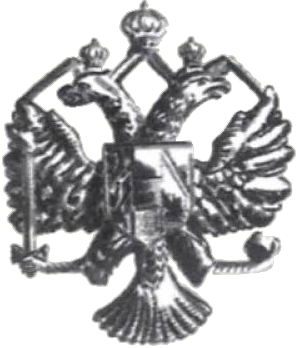
1ST THE QUEEN'S DRAGOON GUARDS
The 1st The Queen's Dragoon Guards (1QDG) were formed in 1959 from two armoured regiments that could trace a lineage back to 1685. The standing enjoyed by cavalry regiments raised under James II secured for them the highest position in the army, second only to the Household Cavalry.
The Queen's title was visited on both regiments but settled on the 2nd in 1727 when their titular head, the Princess of Wales (Caroline of Anspach), became Queen to George II. The Dragoon Guards title came twenty years later, when the three senior regiments of horse were relegated to dragoons with the suffix 'Guards' added to preserve dignity.

Bay mounts used by the 2nd from 1767 played such a prominent part in the regiment's image that it was called 'The Bays'. In 1872 the nickname was upgraded to official title and Queen's Bays was used alongside 2nd Dragoon Guards thereafter. The 1st Dragoon Guards were known by their initials KDG.
Regimental headquarters are at Maindy Barracks in Cardiff, recruiting takes place in Wales and the border counties, and the term 'Welsh Tankies' has been used to describe 1QDG.
The all-blue peaked cap is mounted with an Austrian eagle badge, items of KDG origin. The double-headed eagle, worn as a collar badge in the KDG from 1896, came from the arms of the Emperor Franz Josef of Austria, the Colonel-in-Chief of the regiment at the time. In 1915 the badge was put aside because of Austria's part in the First World War, but was taken on again in 1938.

1QDG bandsmen at a cavalry memorial service in Hyde Park, c. 1990. Note the ex-officer of the Regimental Association, left, with his 'uniform' bowler and rolled umbrella
The collar badge of the 1QDG is the word BAYS in Gothic script within a crowned wreath of bay leaves - formerly the badge of the Queen's Bays. Buttons are stamped with a Gothic Q over DG within the Garter on a crowned star.
Regimental full dress is heavy dragoon pattern: a brass helmet fitted with the scarlet plume of the KDG, a scarlet tunic with the blue facings of the KDG, and blue overalls with the white stripe worn by the Bays to complement their buff white facings adopted in 1855.

Simkin's painting of a private man in the 2nd Dragoon Guards on a bay mount, c. 1806
In barrack dress a regimental stable belt of royal blue may be worn.
The regimental slow march Queen's Dragoon Guards is accompanied by the quick march Radetsky/Rusty Buckles. Bandmaster Herr Schramm introduced Johann Strauss's Radetsky March to the KDG, probably because of its connection with the Austrian ruling family. 'Rusty Buckles' was a nickname for the Bays in the eighteenth century when the heavies spent long periods in Ireland. The new issue of horse brasses was missed and the regiment returned to England with irons rusted by decades of rainy conditions.
The regimental standard bears the cypher of Queen Caroline and the Bays' motto Pro Rege et Patria (For King and Country).
Waterloo/Gazala Day commemorates the regimental days of the KDG and the Bays together. At Waterloo surviving officers and sergeants of the 1st Dragoon Guards pooled their rations and dined together on the battlefield, a simple act of brotherhood the regiment turned into a tradition on Waterloo Day. Gazala Day honours the Bays' north African desert service, notably at the Cauldron and Knightsbridge, where they were in action with tanks for nineteen days continuously in the period 26 May - 21 June 1942.
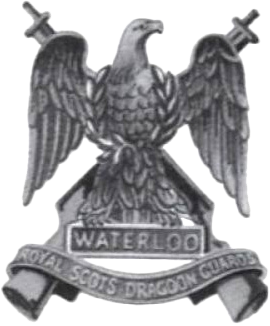
THE ROYAL SCOTS DRAGOON GUARDS
The Royal Scots Dragoon Guards (RSDG) were formed at Holyroodhouse in 1971 from two armoured regiments: the 3rd Carabiniers (Prince of Wales's Dragoon Guards) and the Royal Scots Greys. The 3rd Carabiniers were created in 1922 with the union of the 3rd Dragoon Guards and the Carabiniers (6th Dragoon Guards), both raised in 1685. The Greys, however, had a clear line of descent from 1681 when independent companies of Scottish dragoons, formed three years before to police the militant Covenanters, were made into a regiment.
The name Scots Greys initially came from Hodden grey coats worn by the Scotch Dragoons, but it later related to the grey horses that were procured for the regiment from 1690. It was in this year that the Queen Dowager's Horse gained their honour title at the Battle of the Boyne. William III dubbed the regiment Ring's Carbineers after the continental system of naming outstanding regiments from their arms, in this case the carbine.
The RSDG is Scotland's armoured regiment, with its headquarters at Edinburgh.
The band of the blue peaked cap is uniquely patterned with a yellow zigzag vandyke, the regimental mark of the Greys in the facing colour of the RSDG. Forage caps of the Scots Greys were bound with a vandyke from 1800, recorded in 1840 as being in gold for officers, white for other ranks and yellow for musicians.

A sergeant of the 3rd Dragoon Guards, c. 1905
The RSDG badge, an imperial eagle on crossed carbines, combines the Greys' Waterloo eagle (a replica of the regimental eagle of the French 45th taken in the battle) with carbines extracted from the badge of the 6th Dragoon Guards, adopted unofficially in 1826 with the Carabiniers' title. RSDG buttons carry this badge, though officers wear buttons with a thistle emblem.

The Prince of Wales's crest is worn today on the upper left sleeve to commemorate the 3rd Dragoon Guards, who bore the device from 1765 when they were honoured as the Prince of Wales's Dragoon Guards on the third birthday of the infant prince. Berets and pullovers are grey in this regiment, items of dress inherited from the Scots Greys. Stable belts are blue with adjacent stripes of grey/yellow/red.

Musicians of the RSDG band, c. 1990. The bearskin has a crimson plume
RSDG full dress, provided for drummers and honour guards mounted on greys, is reminiscent of the Scots Greys' uniform. The bearskin, with its Horse of Hanover emblem on the back, is worn with a white plume out of a brass grenade socket or a long crimson plume for trumpeters. It was Queen Anne who authorised the wearing of grenadier caps by the Greys in 1706, following their defeat of three French grenadier regiments at the Battle of Ramillies. The caps evolved to bearskins around 1788, a thistle badge within the circle of St Andrew on the front plate and the Hanover Horse on the back a distinction dropped by the officers around 1800. The bearskins developed full and tall after the Napoleonic Wars, with the long crimson plume across the top for musicians from 1830. A white bearskin, assigned to the kettle drummer between 1887 and 1897, and again from 1937, was thought to have been a gift from the Czar of Russia, Colonel-in-Chief of the Scots Greys until his death in 1917.

Sullivan's painting of the 2nd or Royal North British Dragoons at Waterloo, with bearskins and grey mounts, Sgt Ewart taking the French eagle
The scarlet dragoon tunic bears the yellow facings of the 3rd Dragoon Guards ('The Old Canaries'). The blue overalls are regimentally distinguished by a double stripe, a distinction of the 6th Dragoon Guards, in the yellow facing colour of the RSDG. This abnormality dates from 1851, when the 6th were ordered to India as a regiment of light dragoons. Their heavy dragoon brass helmets were retained but the red jackets were swapped for the braided blue tunics of the light cavalry, and trousers were re-tailored with a light cavalry double stripe in white, the facing colour of the regiment. This hybrid uniform characterised the Carabiniers as much as bearskins did the Greys.
Pipers wear traditional Scottish garb, the feathered bonnet distinguished by the regimental zigzag band. Their kilt and plaid are made of Royal Stuart tartan, a privilege granted to the Greys in 1946 when pipers from disbanding regiments were taken into the regiment.
The regimental slow march Garb Of Old Gaul was once that of the Greys, the quick march 3DGs came from the 3rd Dragoon Guards (composed by Bandmaster Brophy in 1879) and Men of Harlech from the same regiment relates to the Prince of Wales's tradition. Popular Scottish marches are also played and pipers officially march along to My Home in slow time and Highland Laddie in quick time.
In the officers' mess the band traditionally plays God Bless the Prince of Wales (3DG) and The Imperial Russian Anthem in honour of Czar Nicholas II, a custom of the Scots Greys.
Anniversaries celebrated in the RSDG are the regimental birthday (2 July), Waterloo Day (18 June) and Nunshigum Day (13 April), the regimental day of the 3rd Carabiniers, which commemorates the struggle for the Nunshigum Ridge in Burma in 1944. On this day 'B' Squadron is led out on parade by its sergeant major and without officers in memory of a critical stage in the battle when the tank commanders had been picked off by Japanese snipers and Sgt Maj Craddock rallied the squadron to attack the enemy entrenched along the ridge.
In the officers' mess the loyal toast is taken seated, a custom that was practised in both the Greys and the 3DG. The Greys' tradition is reckoned to date back to George III, who often dined with the regiment and may not have been able to rise for the toast.
The RSDG also inherited from the Greys their unique privilege of flying the Scottish royal standard over regimental headquarters and the Queen's personal pipe banner, carried by the pipe major in her presence and on her birthday.
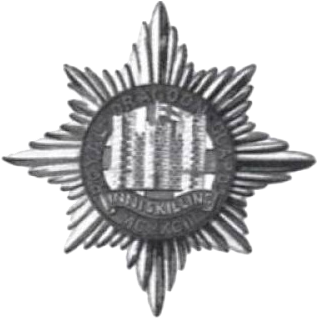
The Royal Dragoon Guards (RDG) were created in 1992 from two armoured regiments formed seventy years previously out of four heavy cavalry regiments that were raised in the troubled days of James II. Regimental headquarters are at York.

The Royal Dragoon Guards desert training with Omani forces. (MoD)
The 4th/7th Renal Dragoon Guards emerged from the union of the 4th (Royal Irish) Dragoon Guards and the 7th (Princess Royals) Dragoon Guards, which were commissioned as a regiment by William III after giving aid to Princess Anne in her flight from London in 1688.
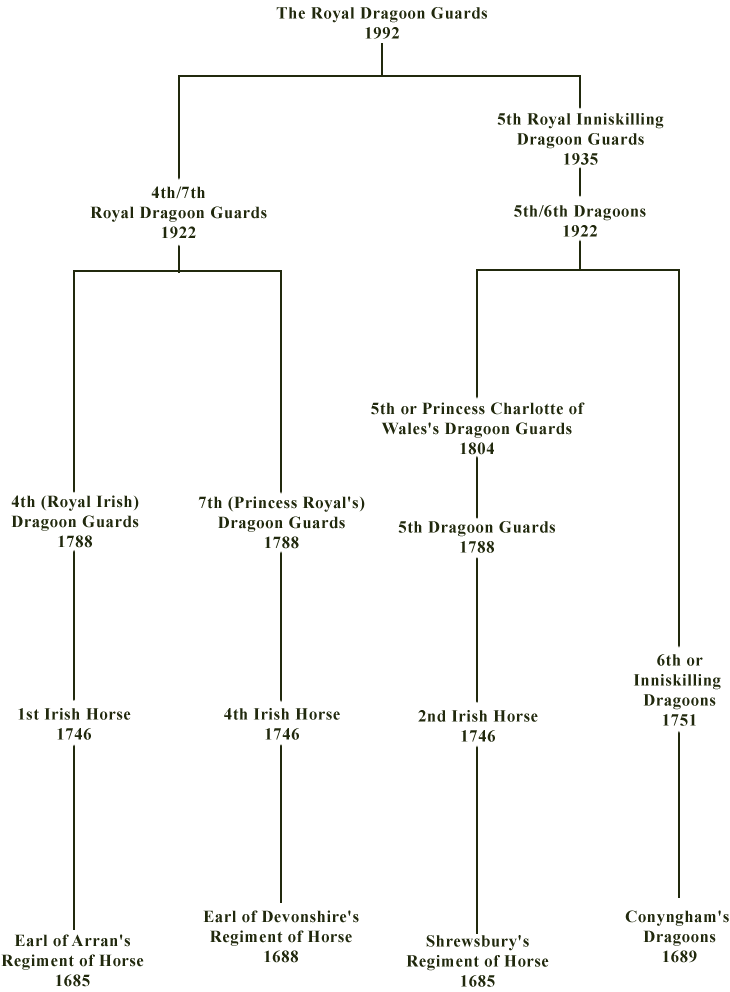
The 5th Royal Inniskilling Dragoon Guards were the result of the 1922 linking of the 5th Dragoon Guards, one of six horse regiments raised in 1685, with the 6th Inniskilling Dragoons ('The Skins') formed in 1689 from the Protestant defenders of Enniskillen, fighting against the Catholic supporters of the deposed James.

Standard-bearer and escort of the 7th Dragoon Guards, brass helmets fitted with a black/white plume, black collars mounted with the Earl of Ligonier's crest
The blue peaked cap and star badge are 4/7RDG in origin. The Star of the Order of St Patrick was authorised to the 4th (Royal Irish) Dragoon Guards in 1838 when they were in London for the coronation of Queen Victoria. From 1904 their star badge bore the Roman numerals MDCCLXXXIII, being the year in which the order was instituted (1783), and the motto Quis separabit (Who shall separate us?). The 4th/7th used this star for their cap badge, but with its centre shamrock design substituted by the cross from the Order of the Garter superimposed with the coronet of the Princess Royal from the insignia of the 7th Dragoon Guards.

RDG, 1998, the RQMS at left with the Salamanca Staff. (Grenadier Publishing)
In adopting this badge the RDG changed its inscription to ROYAL DRAGOON GUARDS MCMXCII, being their date of formation (1992), and replaced the central coronet with the castle of Enniskillen with St George's flag flying (the badge of the Inniskillings and collar badge of the 5RIDG).
Senior NCOs wear a Horse of Hanover badge with their ranking, a custom of the 5th Dragoon Guards who gained the emblem in 1804 with their Princess Charlotte of Wales's title and the motto Vestigia nulla retrorsum (No going backward).
Service dress is noticeable for its use of green trousers (the modern mark of Irish ancestry) and the D-Day sleeve flash. This diamond shape flash was issued in 1944 and retained by the 4th/7th to commemorate their 'First and Last' reputation, acquired after the Daily Telegraph reported the regiment's tanks were First onto and last off the Normandy beaches. This echoes the First World War, when the 4th Dragoon Guards reputedly made the first kill of the war (at Casteau on 22 August 1914) and the 7th Dragoon Guards the last (at Lessines on 11 November 1918). No. 1 dress 'blues' are worn with green trousers or green overalls fashioned with a primrose-yellow stripe, a distinction of the 5RIDG, green being the facing colour of the 5th and yellow the facing colour of the Inniskillings.
Full dress and mess jackets are scarlet with blue facings.
The regimental quick march Fare Ye Well Inniskilling was adopted by 5RIDG in 1952 to replace The Skins' Sprig o'Shillelagh and the 5th Dragoon Guards' Soldiers Chorus. It was written by Bandmaster Adams, based on the old ballad The Inniskilling Dragoon.
The regimental slow march is the same as that arranged for the 4th/7th: the opening refrain of The Blue Horse March, named after the eighteenth-century nickname of the 4th Dragoon Guards from their blue facings, leading into The Black Hone March of the 7th, similarly named after their facing colour. The eighteenth century was a colourful time for the 7th, who were also called 'The Virgin Mary's Bodyguard' after a remark attributed to men of the Royal Horse Guards, contemptuous of the high number of Catholics in the Black Horse at the time of the War of the Austrian Succession.
Before taking the loyal toast in the officers' mess the Belgian national anthem would be played to honour King Leopold III, who had succeeded his father as Colonel-in-Chief of the 5RIDG in 1937. This ritual had come down from the 5th Dragoon Guards, who used to play the anthem for King Albert I, Colonel-in-Chief of the 5th from 1915.
St Patrick's Day (17 March) is observed as a regimental holiday, when breakfast is served by the officers and NCOs, with 'gunfire' tea and shamrock. Irish stew is the norm for lunch, with a sports afternoon for dessert. On the Sunday closest to 17 March the regiment remembers the bravery of Capt Oates of the Inniskilling Dragoons, who sacrificed himself on Scott's 1912 Antarctic expedition in order to give his comrades a better chance of survival. Oates Sunday was observed by the 5RIDG.
Another custom of the regiment, revived by Maj Gen Evans in 1930, is the French drum major's mace. It is paraded by a warrant officer on Salamanca Day (22 July) with its inscription, 'This trophy was taken in the charge by the 5th Dragoon Guards at the Battle of Salamanca, 22nd July, 1812, in which, among others, the 66th French Regiment was annihilated. Major General Ponsonby begs leave to present it to the 5th Dragoon Guards to be carried by the Trumpet Major on all occasions of review as a memory of That Glorious Day.'
The Dettingen Day celebrations of the 4th/7th are perpetuated on a weekend near to 27 June with a regimental revue and families' day. At the Battle of Dettingen in 1743, Ligonier's Regiment of Horse (later the 7th Dragoon Guards) got cut off from the main body and had to plough their way back through the enemy to their own lines. Cornet Richardson suffered thirty-seven sword cuts and bullet wounds in his defence of Ligonier's standard. Earl Ligonier developed his regiment to a high level of efficiency between 1720 and 1749, and in 1899 his crest and motto were adopted by the 7th as their badge.
Greetings are sent to regiments that participated with the 4th, 5th and 6th in the Charge of the Heavy Brigade at Balaklava in 1854.

Queen's Own Hussars on a freedom march in Birmingham on the tercentenary of the regiment in 1985
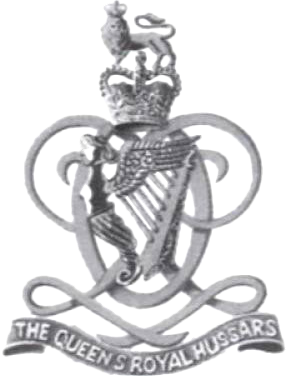
We have much more interesting information on this site.
Click MENU to check it out!
∎ cartalana.com© 2009-2025 ∎ mailto: cartalana@cartalana.com